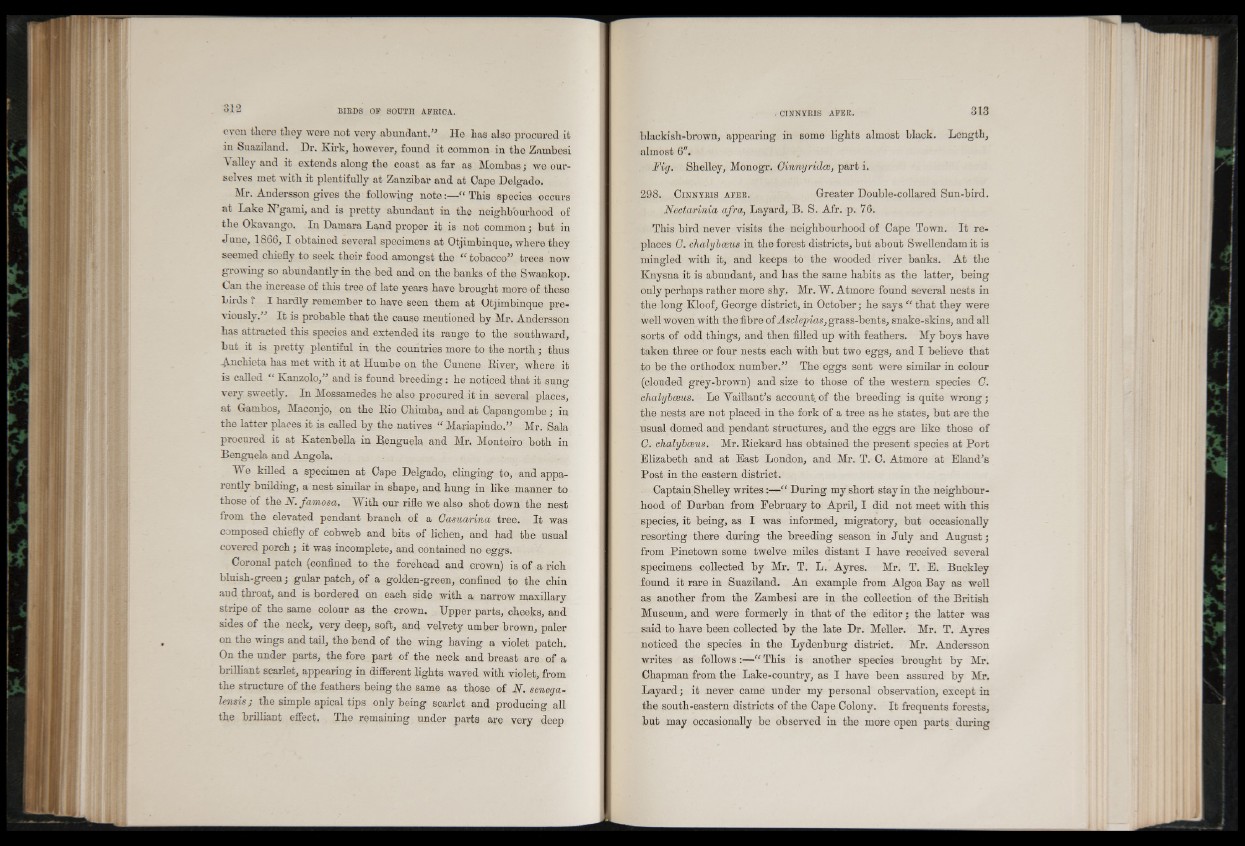
even tlioro tlioy wore not very abundant.” He has also procured it
in Suaziland. Dr. Kirk, however, found it common in the Zambesi
'Valley and it extends along the coast as far as Mombas; we ourselves
met with it plentifully at Zanzibar and at Cape Delgado.
Mr. Andersson gives the following note:—“ This species occurs
at Lake N’gami, and is pretty abundant in the neighbourhood of
the Okavango. In Damara Land proper it is not common; but in
June, 1866, I obtained several specimens at Otjimbinque, where they
seemed chiefly to seek their food amongst the “ tobacco” trees now
growing so abundantly in the bed and on the banks of the Swankop.
Can the increase of this tree of late years have brought more of these
birds ? I hardly remember to have seen them at Otjimbinque previously.”
It is probable that the cause mentioned by Mr. Andersson
has attracted this species and extended its range to the southward,
but it is pretty plentiful in the countries more to the north; thus
Anchieta has met with it at Humbe on the Cunene River, where it
is called “ Kanzolo,” and is found breeding: he noticed that it sung
very sweetly. In Mossamedes he also procured it in several places,
at Gamhos, Maconjo, on the Rio Chimba, and at Capangombe j in
the latter places it is called by the natives “ Mariapindo.” Mr. Sala
procured it at Katenbella in Rengúela and Mr. Monteiro both in
Rengúela and Angola.
We killed a specimen at Cape Delgado, clinging to, and apparently
building, a nest similar in shape, and hung in like manner to
those of the N. famosa, With our rifle we also shot down the nest
from the elevated pendant branch of a Gasuarina tree. It was
composed chiefly of cobweb and bits of lichen, and had the usual
covered porch; it was incomplete, and oontained no eggs.
Coronal patch (confined to the forehead and crown) is of a rich
bluish-green; guiar patch, of a golden-green, confined to the chin
and throat, and is bordered on each side with a narrow maxillary
stripe of the same colour as the crown. Upper parts, cheeks, and
sides of the neck, very deep, soft, and velvety umber brown, paler
on the wings and tail, the bend of the wing having a violet patch.
On the under parts, the fore part of the neck and breast are of a
brilliant scarlet, appearing in different lights waved with violet, from
the structure of the feathers being the same as those of N. senega-
lensis; the simple apical tips only being scarlet and producing all
the brilliant effect, The remaining under parts are very deep
blackish-brown, appearing in some lights almost black. Length,
almost 6".
Fig. Shelley, Monogr. Oinnyridce, part i.
298. C in n y r is a f e r . Greater Double-collared Sun-bird.
Nectarinia afra, Layard, R. S. Afr. p. 76.
This bird never visits the neighbourhood of Cape Town. It replaces
0. chalybceus in the forest districts, but about Swellendam it is
mingled with it, and keeps to the wooded river banks. At the
Knysna it is abundant, and has the same habits as the latter, being
only perhaps rather more shy. Mr. W. Atmore found several nests in
the long Kloof, George district, in October; he says “ that they were
well woven with the fibre of Asclepias, grass-bents, snake-skins, and all
sorts of odd things, and then filled up with feathers. My boys have
taken three or four nests each with but two eggs, and I believe that
to be the orthodox number.” The eggs sent were similar in colour
(clouded grey-brown) and size to those of the western species G.
chalybceus. Le Yaillant’s account, of the breeding is quite wrong ;
the nests are not placed in the fork of a tree as he states, but are the
Usual domed and pendant structures, and the eggs are like those of
G. chalybceus. Mr. Rickard has obtained the present species at Port
Elizabeth and at East London, and Mr. T. C. Atmore at Eland’s
Post in the eastern district.
Captain Shelley writes :—“ During my short stay in the neighbourhood
of Durban from February to April, I did not meet with this
species, it being, as I was informed, migratory, but occasionally
resorting there during the breeding season in July and August;
from Pinetown some twelve miles distant I have received several
specimens collected by Mr. T. L. Ayres. Mr. T. E. Euckley
found it rare in Suaziland. An example from Algoa Ray as well
as another from the Zambesi are in the collection of the Eritish
Museum, and were formerly in that of the editor: the latter was
said to have been- collected by the late Dr. Meller. Mr. T. Ayres
noticed the species in the Lydenburg district. Mr. Andersson
writes as follows :—“ This is another species brought by Mr.
Chapman from the Lake-country, as I have been assured by Mr.
Layard; it never came under my personal observation, except in
the south-eastern districts of the Cape Colony. I t frequents forests,
but may occasionally be observed in the more open parts during